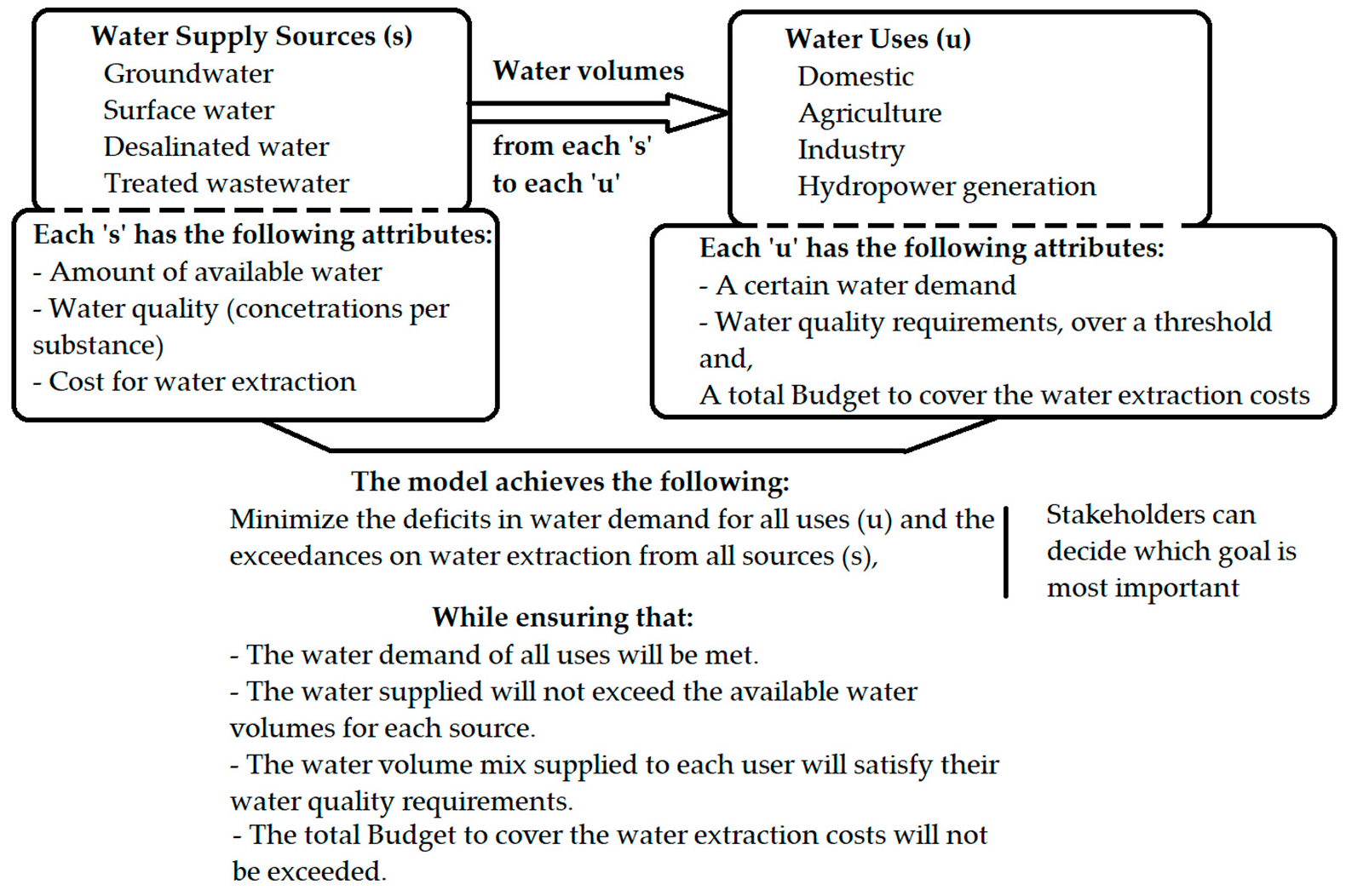A Multi-Objective Optimization Framework for Water Resources Allocation Considering Stakeholder Input †
Abstract
1. Introduction
2. Conceptual and Mathematical Description of the Model
- : deficit in water demand for user u [m3/year].
- : exceedance (above renewable level) of water extraction of source s [m3/year].
- : volume of water demanded by user u [m3/year].
- : volume of water availability (renewable resources) of source s [m3/year].
- : binary parameter equal to one if it is feasible to allocate water from source s to user u, and zero otherwise.
- : concentration of substance q in water from source s [g/m3].
- : threshold of maximum allowable concentration of substance q to meet quality requirements for user u [g/m3]. Each user u can have its own mix of quality parameters (e.g., dissolved solids, phosphorous, nitrogen, etc.).
- : unitary water extraction cost of source s [$/m3].
- : budget allocated for water provision [$/year].
3. Stakeholder Input
4. Concluding Remarks
Supplementary Materials
Author Contributions
Funding
Institutional Review Board Statement
Informed Consent Statement
Data Availability Statement
Conflicts of Interest
References
- Greve, P.; Kahil, T.; Mochizuki, J.; Schinko, T.; Satoh, Y.; Burek, P.; Fischer, G.; Tramberend, S.; Burtscher, R.; Langan, S.; et al. Global Assessment of Water Challenges under Uncertainty in Water Scarcity Projections. Nat. Sustain. 2018, 1, 486–494. [Google Scholar] [CrossRef]
- Souza da Silva, G.N.; de Moraes, M.M.G.A. Economic Water Management Decisions: Trade-Offs between Conflicting Objectives in the Sub-Middle Region of the São Francisco Watershed. Reg. Environ. Chang. 2018, 18, 1957–1967. [Google Scholar] [CrossRef]
- Alamanos, A.; Koundouri, P.; Papadaki, L.; Pliakou, T.; Toli, E. Water for Tomorrow: A Living Lab on the Creation of the Science-Policy-Stakeholder Interface. Water 2022, 14, 2879. [Google Scholar] [CrossRef]
- Alamanos, A.; Xenarios, S.; Mylopoulos, N.; Stålnacke, P. Integrated Water Resources Management in Agro-Economy Using Linear Programming: The Case of Lake Karla Basin, Greece. Eur. Water 2017, 60, 41–47. [Google Scholar]
- Naghdi, S.; Bozorg-Haddad, O.; Khorsandi, M.; Chu, X. Multi-Objective Optimization for Allocation of Surface Water and Groundwater Resources. Sci. Total Environ. 2021, 776, 146026. [Google Scholar] [CrossRef]
- Majedi, H.; Fathian, H.; Nikbakht-Shahbazi, A.; Zohrabi, N.; Hassani, F. Multi-Objective Optimization of Integrated Surface and Groundwater Resources Under the Clean Development Mechanism. Water Resour. Manag. 2021, 35, 2685–2704. [Google Scholar] [CrossRef]
- Garcia, J.A.; Alamanos, A. Integrated Modeling Approaches for Sustainable Agri-Economic Growth and Environmental Improvement: Examples from Greece, Canada and Ireland. Land 2022, 11, 1548. [Google Scholar] [CrossRef]
- Tarebari, H.; Javid, A.H.; Mirbagheri, S.A.; Fahmi, H. Multi-Objective Surface Water Resource Management Considering Conflict Resolution and Utility Function Optimization. Water Resour. Manag. 2018, 32, 4487–4509. [Google Scholar] [CrossRef]
- Charnes, A.; Cooper, W.W. Management Models and Industrial Applications of Linear Programming; John Wiley: New York, NY, USA, 1961; Volumes 1–2. [Google Scholar]
- Rojas, R.; Castilla-Rho, J.; Bennison, G.; Bridgart, R.; Prats, C.; Claro, E. Participatory and Integrated Modeling under Contentious Water Use in Semiarid Basins. Hydrology 2022, 9, 49. [Google Scholar] [CrossRef]
- Loucks, D.P.; van Beek, E. Water Resource Systems Planning and Management: An Introduction to Methods, Models, and Applications; Springer Nature: Berlin, Germany, 2017; ISBN 978-3-319-44234-1. [Google Scholar]

| Stakeholder Group A: Representatives from the central Government. This group refers to representatives from the Ministry of Environment, the Environmental Protection Agencies (EPA), General Water Directorate, Agency of Land Reclamation Works, or relevant bodies of climate, energy, agriculture, etc., depending on the management structure of each country. These stakeholders operate at a higher-level, providing more general guidelines (e.g., River Basin Management Plans), so they can be key for connecting their more general guidelines to the actual decisions at a smaller scale. |
| Stakeholder Group B: Representatives from the regional-scale authorities, such as regional governments, the Prefecture, State or Municipal Division level agencies depending on the country. They are often responsible for implementation of the higher-level guidelines at the regional scale and for tracking the progress, so it will be useful to stay connected with all other stakeholder groups. |
| Stakeholder Group C: Local authorities, industry stakeholders, agricultural co-operations relating to water and agricultural management, organizations of land reclamation, urban regulators, and representatives of municipal institutions. Continuous dialogue with stakeholder groups A and B will help seek the proper expertise and skills and consider the broader picture of the goals discussed, in order to apply any measure with the maximum efficiency. Non-Governmental Organizations (NGOs) can be a part of this group, or a separate one, depending on the connection with the other stakeholders and, often, on the alignment of their environmental policies. |
| Stakeholder Group D: Experts and experienced professionals; start-ups and technology experts; researchers and academics. These will play the role of the solution holders in theoretical and practical terms, and will also provide feasibility considerations with respect to the application of the different decisions discussed. |
Disclaimer/Publisher’s Note: The statements, opinions and data contained in all publications are solely those of the individual author(s) and contributor(s) and not of MDPI and/or the editor(s). MDPI and/or the editor(s) disclaim responsibility for any injury to people or property resulting from any ideas, methods, instructions or products referred to in the content. |
© 2023 by the authors. Licensee MDPI, Basel, Switzerland. This article is an open access article distributed under the terms and conditions of the Creative Commons Attribution (CC BY) license (https://creativecommons.org/licenses/by/4.0/).
Share and Cite
Garcia, J.A.; Alamanos, A. A Multi-Objective Optimization Framework for Water Resources Allocation Considering Stakeholder Input. Environ. Sci. Proc. 2023, 25, 32. https://doi.org/10.3390/ECWS-7-14227
Garcia JA, Alamanos A. A Multi-Objective Optimization Framework for Water Resources Allocation Considering Stakeholder Input. Environmental Sciences Proceedings. 2023; 25(1):32. https://doi.org/10.3390/ECWS-7-14227
Chicago/Turabian StyleGarcia, Jorge Andres, and Angelos Alamanos. 2023. "A Multi-Objective Optimization Framework for Water Resources Allocation Considering Stakeholder Input" Environmental Sciences Proceedings 25, no. 1: 32. https://doi.org/10.3390/ECWS-7-14227
APA StyleGarcia, J. A., & Alamanos, A. (2023). A Multi-Objective Optimization Framework for Water Resources Allocation Considering Stakeholder Input. Environmental Sciences Proceedings, 25(1), 32. https://doi.org/10.3390/ECWS-7-14227






